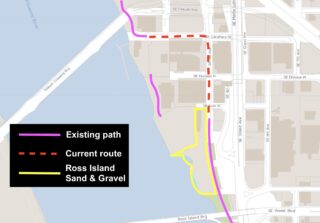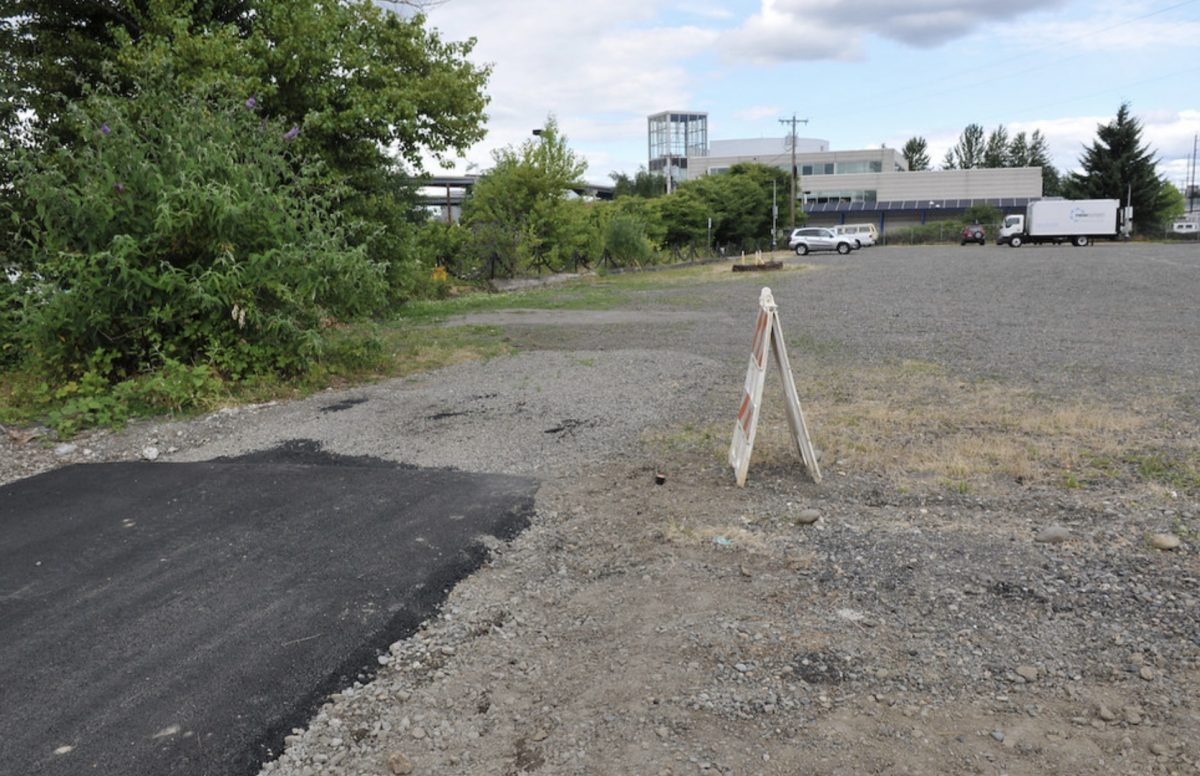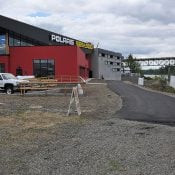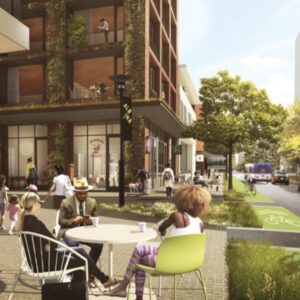
(Photos: Jonathan Maus/BikePortland)

A three-acre parcel on the Willamette River adjacent to the Springwater Corridor path is up for sale. If the property changes hands, it could hasten development of a key section of riverfront path that would bring us closer to filling the gap between the Eastbank Esplanade and the Springwater that currently forces a detour onto surface streets.
According to a sales brochure published by real estate company CBRE, the former Ross Island Sand & Gravel facility at 2611 SE 4th Avenue is being sold for $3.195 million. The listing boasts of access to public transit, riverfront views, and a “rare” large waterfront development site.
In early 2019 Ross Island Sand & Gravel owner RB Pamplin Corporation closed the company’s concrete division based at this location, laid off dozens of workers and sold off most of the equipment.
This is one of four properties on the riverfront between the end of the Eastbank Esplanade at the Portland Opera building and the Springwater Corridor path at the Ross Island Bridge. The City of Portland owns a trail easement on the riverfront, but has been unable to fully connect this 1,800 foot gap.
Advertisement
In 2006 when another one of these four properties changed hands the owners fought tooth-and-nail against building the path. A 29-month legal battle ensued before watercraft retailer SK Northwest finally relented. In 2011, five years after the fight started, the company paved a section of the Springwater Corridor that currently sits as an unused island between two undeveloped parcels.
The SK Northwest path is about 350 feet. The Ross Island Sand & Gravel parcel would be another 600 feet. If the new owners built a path that would leave only about 850 feet remaining. Unfortunately one of the remaining parcels is owned by American Waterways, Inc., the parent company of Portland Spirit, a cruise boat operator that has been ardently opposed to building the path in the past.
If a buyer for the Sand & Gravel parcel steps forward they’ll face a lot of public pressure to build the path. Will it help topple the remaining two dominoes and get us a fully connected Esplanade-Springwater? Time will tell. We’ve got feelers out to Portland Parks & Recreation (they manage the paths) and the Bureau of Development Services to learn more. Stay tuned.

— Jonathan Maus: (503) 706-8804, @jonathan_maus on Twitter and jonathan@bikeportland.org
— Get our headlines delivered to your inbox.
— Support this independent community media outlet with a one-time contribution or monthly subscription.







Thanks for reading.
BikePortland has served this community with independent community journalism since 2005. We rely on subscriptions from readers like you to survive. Your financial support is vital in keeping this valuable resource alive and well.
Please subscribe today to strengthen and expand our work.
How is this area zoned these days? Is residential a possibility? If this becomes apartments or condos, it seems like getting the path through may become more likely.
It’s zoned for heavy industry.
https://www.portlandmaps.com/detail/property/2611-SE-4TH-AVE/R197256_did/
Definitely still zoned heavy industrial. That doesn’t preclude a path however. And I suppose a zoning change could occur. I’m hoping to learn more from BDS soon.
Yeah, I’m not necessarily in favor of getting rid of all the close-in industrial jobs, but I suspect that land would be much more valuable with residential zoning and the views are kind of wasted on an industrial site.
It’s zoned “Heavy Industry” but could be rezoned to the more flexible “General Industry” without requiring city council action. Changing to a zone that allows residential would require city council to change the Comprehensive Plan designation, and for various reasons that would be a heavy lift.
With that said, the site has a trail mapped on it in the zoning map, and is therefore subject to the standards of chapter 33.272 Major Public Trails. Any substantial redevelopment of the site—for any use, including industrial—is going to trigger the requirement to build the trail.
Realistically I think this site would be hard to develop, given the newly required setbacks from the river (for any use other than river dependent uses). The value would really come when combined with the vacant site to the north… which, from a trail perspective, would be good.
The Major Public Trails alignment in the Zoning Map goes straight through this site, so there hopefully is a nexus to require the trail connection.
Stop Demolishing Old Portland! These structures represent a foundational piece of Portland history and should be preserved for future generations.
I do not mean transforming them into family -friendly brew -pubs. Architecturally significant is what they are. Sig Nificant.
Some parts of Olde Portland were not so great.
Industrial gravel plants and associated work that pollutes the riverfront are critical to the character of Portland.
I actually think it would be pretty cool to save the structures, but unless someone wants to re-open a ready mix concrete facility, that probably means saving them as relic as part of a new riverfront park, an office development… or a family friendly brewpub. The chances that those structures would be saved as part of any continued industrial presence on the site are very very slim.
This was done in the Dalles. Sunshine Mill Could be cool here, too.
FWIW that Sunshine Mill place is really awesome. Been there a few times. Very cool space. Also in related news… They make a cool wine-in-a-cup product that is perfect for biking ;-).
Thinking this could be Portland’s version of Gas Works park in Seattle. But yes, otherwise there likely will be little use for a prospective buyer. and it seems silly to try to preserve obsolete industrial structures in prime real estate just for “character”.
Could be a nice house and offices for someone: https://www.thisiscolossal.com/2017/02/architect-ricardo-bofills-abandoned-cement-factory-residence-and-studio/
That company absolutely ripped Ross Island to pieces. Giving something back to the community (like a trail, for example) would be a great result of this sale.
Okay, then you buy the site and try to run a profitable concrete business. Good luck with that.
Do you think we should have preserved all the horse barns that used to be in the city too? Should the whole damn city be a museum that people can neither work in nor live in?
How many historically significant industrial buildings can we save in a time when housing at any price is hard to find and affordable housing is becoming impossible to find?
At what point do we say that housing people must come first?
That and, just because it’s old doesn’t mean it’s culturally significant. As someone else pointed out, the Ross Island Sand and Gravel co gutted Ross Island. I realize resources are vital for growth, but I’m against enshrining decrepit buildings where environmental devastation occurred. Better to put ugly high rises there than maintain the carcass of an exploitative industry. Of course, a nature reserve would be the best outcome.
https://www.pdxmonthly.com/travel-and-outdoors/2010/04/ross-island-0510
That makes no sense; doesn’t the Chrysler Building retain its importance despite the toll that that company has taken on our climate (and the generally crappy vehicles they foisted upon the world)?
I am agnostic about the cultural significance (or architectural potential) of the structures at the site, but the company’s impact on Ross Island doesn’t seem relevant to deciding their fate.
Oh, you want an argument, how surprising.
According to your preferred tome of knowledge, the Chrysler Building is in Chicago. Not really on topic.
https://en.wikipedia.org/wiki/Chrysler_Building
It’s exactly on-topic if the question is whether cultural/architectural value of a structure is related to the environmental mayhem caused by its occupants. I think the answer is “it’s not”.
To clarify: the Chrysler Building is completely irrelevant because 1) Chrysler was never the single occupant of the building 2) the work conducted at the RISG site was directly impactful to the environment 3) the Chrysler Building is in Chicago, it’s up to Chicago citizens to decide how to manage their historical structures. Not you and not I.
If you had said “a Chrysler factory in Portland” it would be relevant.
Isn’t the Chrysler building in New York City?
Yes, I was testing to see if Hello Kitty was actually reading my arguments or just replying blindly. A test as it were. They did not pass the test.
As you said, the location doesn’t matter because it is not here.
It doesn’t matter if she verified where it was. Or maybe she knew where it was but was letting you continue with your own error – she’s cagey like that.
Your opinion — that you’re against enshrining buildings where environmental devastation occurred, if those buildings had a single occupant, where the environmental impact by that occupant was direct (as opposed to indirect like manufacturing and selling cars), and if they are in Portland — did not seem to hinge on your knowing whether the Chrysler Building was in NY or Chicago.
Sorry I failed your test.
I think you just did a straw man there. I did not say I was against enshrining these buildings. In fact, that was never a facet of my argument. Nor am I saying that they are worthy of destruction because they had a single occupant.
Actually, in the interest of intellectual honesty, I did say I was against enshrining the building(s).
Straw man still stands though because you misread my “occupancy” clause.
Why that is important: the Chrysler building is just an office building. No direct correlation can be drawn between that particular office building and environmental damage more so than any other office building. Only the moniker of the building hints at environmental impact. Since the building has been occupied by innumerable companies, you can’t simply say, “hey it’s called ‘The Big Car Tower’ it must represent environmental devastation!” Bearing the moniker of Chrysler is not enough to align the building with the “environmental mayhem” caused by the Chrysler corp.
So, on that you have made an error in understanding why I made a point of it. You churlishly portrayed my statement incorrectly. Thus, a straw man was made.
“I’m against enshrining decrepit buildings where environmental devastation occurred.”
The Ross Island Gravel building is not on Ross Island. Therefore, the destruction happened elsewhere.
The connection between the building and the company was a lot stronger than just “bearing the moniker”. The building was built and owned by Walter Chrysler, and built to be the company’s headquarters, which it was for over two decades. It was totally “Look at me!” architecture–the world’s tallest, extremely flamboyant building in a city with the world’s largest collection of those. It even has auto-inspired detailing–giant cast aluminum hubcaps and radiator caps, for example.
So anyone who wants to tie the Chrysler building to the Chrysler company (and its “environmental mayhem” or whatever) not only has a good case, they have a better case than would be true with almost any other building and company on earth.
Portland was built on Ross Island Gravel!
Asserting that one value is most important (affordable housing) is not to say we can’t have other values as well. As a city, we have to be able to do more than one thing at a time, and I see no conflict between affordable housing and preservation of unique industrial structures (assuming the structures are worth preserving).
That ugly nasty stuff can’t be demolished fast enough. This should be rezoned as that is a terrible place for heavy industry. Heavy industry used to be sited along the river for a reason. Finally we can start rehabbing Ross Island.
The fundraising for the preservation work is in full swing! Check us out on Go-Fund-Yourself, or donate through Street Fund Trust, or you and your kids help out through the Center’s fall work-camp program. AAIA architects are taking up the cause and other cities are again looking to Portland to learn about the care of their heirloom industrial structures. If you look carefully, you can still find unmolested remnants of Doomtown, the city onwhich New-Portland now stands.
I hope good things come of this, though the headline had me hoping that the property for sale was their lot by SE Holgate Blvd. That property is one of the best opportunities for re-establishing river access for the Brooklyn neighborhood, a project that has been punted for decades. In fact, there’s already a path there, it’s just a private RI S&G road that’s off-limits to the public.
More info: https://brooklyn-neighborhood.org/river-access/ (I’m the neighborhood association chair and familiar with the issue, AMA.)
I think that one is for sale also! Curious what city requirements for trails, streets, or connectivity through the site would be.
The floating boathouse would make a great rowing/paddling clubhouse!
$3.2 mil, that’s cheap. Dirt cheap. 😐
Does anyone know if they are pulling out because all the gravel on the Island is gone? Or is their some other business reason.
Mining stopped on the island in 2001. They’ve been working on restoring the island and lagoon for the last 10+ years. The property being sold is just the cement plant.
They’re doing the bare minimum they need to do to hand off the island to the City. Dredging to remove decades of pollution that they created isn’t really “restoration”. The island will never look the way it did before they started mining:
“In 2007, the owner of RISG, Robert B. Pamplin, Jr., donated 45 acres (18 ha) of the island to the city of Portland, which plans to manage the property as a natural area.[5] The islands, which retain remnants of forested riparian zones, are used by at least 50 species of birds including ospreys, eagles, herons.[4] The gift was accepted long after transfer negotiations stalled in 2002 over questions of liability for the islands’ restoration and cleanup.[1] Because it contains toxic fill dirt, the Ross-Hardtack lagoon is listed for cleanup by the Oregon Department of Environmental Quality.[3] City staff and outside experts who inspected the 45 acres (18 ha) in 2007 approved of their condition.[1]”
If the city can find $3.2 million by any necessary means, we should buy it. Restore the riverfront with some public access, link the trail, and turn the rest into a jobs incubator aimed at diversifying the economy.
I’m still chewing on what that last bit would look like. If it could be done in the shell of existing structures, fine.
Why the city, you say? It seems likely the market is going to give us a tech beehive, or a brew pub/cannabis emporium, or some other thing that we already have a bunch of. Parking structure. Boutique hotel. The market goes with what worked before a lot of the time.
A trail might not seem like an economic asset but it is my strong belief that we should connect and enhance long stretches of bikeway where ever possible. This site has existing tendrils of grade seperated bikeway to the South and East (Springwater/Trolley), the North (Esplanade), and other incipient connections as well. A tiny fraction of the money that is proposed for the Rose Quarter freeway widening project would give our bikeway network a heart.
I always wondered why the path detoured onto surface streets here. Hope they’re able to connect the two!
Why does the Portland Spirit not have more public spirit? If they hate people in Portland so much that they’ll fight tooth and nail against the people’s access to the river, then maybe people should start opposing any and all permits/privileges they have or have to get to run their operation.